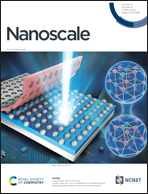Effect of thiolate-ligand passivation on the electronic structure and optical absorption properties of ultrathin one and two-dimensional gold nanocrystals†
Abstract
Gold nanomaterials, including one-dimensional (1D) gold nanorods (AuNRs) and nanowires (AuNWs) and two-dimensional (2D) gold nanoprisms with a large surface area and stability, have attracted widespread research interest. A large number of experimental and theoretical studies have shown that the properties of low dimensional gold nanomaterials depend on their anisotropic shape. In this work, we theoretically conceived a new type of gold nanomaterial, namely, thiolate (SR) monolayer passivated quasi-1D and quasi-2D gold nanocrystals and infinite superstructures, which were formed by the fusion of seed clusters Au28(SR)20, Au36(SR)24, Au44(SR)28 and Au52(SR)32 or the layer by layer growth of gold atoms along the [100] and/or [010] directions. By means of DFT and TD-DFT calculations, the structure and properties of these model gold nanocrystals and superstructures are studied in depth. It is found that the passivation of the monolayer of thiolate leads to significantly improved near-infrared absorption properties in comparison with the ligand free gold nanocrystals. Upon passivating the thiolate-monolayer, the ultrathin 1D gold nanowire and 2D gold nanosheet demonstrate a metal to semiconductor transition. The novel electronic structures, optical absorption and semiconductor-to-metal transition found in these thiolate-protected low-dimensional gold nanocrystals suggest that the passivation of the SR ligand is a promising way to tailor the properties of gold nanomaterials.



 Please wait while we load your content...
Please wait while we load your content...